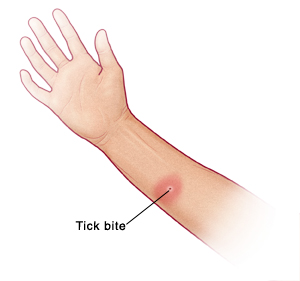You've been bitten by a tick. Ticks are small arachnids that feed on the blood of rodents, rabbits, birds, deer, dogs, and people. A tick bite may cause redness, itching, and mild swelling at the site. Sometimes, you may have no reaction where the tick bit you.
Most tick bites are harmless. But some ticks carry more serious diseases, such as Lyme disease or Rocky Mountain spotted fever. These can be passed to people at the time of the bite. Lyme disease is of greatest concern. Right now, you have no symptoms of Lyme disease or other serious reaction to the bite. It's important to watch for the warning signs, which could appear weeks or months after the tick bite. If you are concerned, many states have agencies that will test the tick that bit you for disease. Check with your local officials to see if this service is offered in your area.
Home care
The following will help you care for your bite at home:
-
If itching is a problem, don't wear tight clothing. Also, avoid anything that heats up your skin. This includes hot showers or baths and direct sunlight. This will tend to make the itching worse.
-
An ice pack will reduce local areas of redness and itching. Make your own ice pack by putting ice cubes in a plastic bag that seals at the top. Wrap the bag in a clean, thin towel. Never put ice or an ice pack directly on the skin.
-
Creams containing benzocaine will reduce itching. These creams are available over the counter.
-
You can use an antihistamine with diphenhydramine if your healthcare provider did not give you another antihistamine. This medicine may be used to reduce itching and inflammation. Be aware that it may cause drowsiness. It's available at pharmacies and grocery stores. If symptoms continue, talk with your provider or pharmacist about other medicines that may reduce symptoms.
Follow-up care
Follow up with your healthcare provider, or as advised.
When to get medical advice
Call your healthcare provider right away if any of these occur:
Signs of local infection. Watch for these during the next few days:
-
Increasing redness around the bite site
-
Increased pain or swelling
-
Fever over 100.4°F (38.0°C), or as advised by your provider
-
Fluid draining from the bite area
Get medical care right away for signs of tick-related disease. Watch for these during the next few weeks or months:
-
Circular, red, ring-like rash appears at the bite area in 1 to 3 weeks
-
A non-itchy red rash develops on your wrists or ankles and spreads. It may become purple (petechiae).
-
Red eyes
-
Tiredness, fever or chills, nausea or vomiting
-
Neck pain or stiffness, headache, or confusion
-
Muscle or bone aches
-
Irregular or fast heartbeat
-
Joint pain or swelling, especially in the knee
-
Numbness, tingling, or weakness in the arms or legs
-
Weakness on one side of the face


